11 covered outdoor kitchen ideas for sheltered cooking and dining
Enjoy your outdoor kitchen all year round


Experimenting with covered outdoor kitchen ideas can transform your outdoor living space into a hub for alfresco dining. There are countless outdoor kitchen ideas for every garden, big or small, but there's also plenty of room for creativity if you want to enclose your dining area and protect it from the elements.
'A covered kitchen allows for more frequent use regardless of the weather, making it a practical addition to any outdoor space,' says Sam Jenkinson, pergola expert at Tiger. 'The cover also offers shade and shelter, enhancing the comfort of the area for cooking and dining.'
No matter the size of your alfresco space – even if you're looking for small outdoor kitchen ideas – if you want to provide the area with a little more protection, you've come to the right place.

Sam Jenkinson has been at Tiger for over four years and has built up a vast knowledge and experience in all areas of the products. He is a keen gardener and self-proclaimed 'shed head'.
Protecting your outdoor cooking space from the elements will allow you to make use of it all year round.
So, whether you're looking to weatherproof your garden bar ideas or ensure an outdoor kitchen adds value to your home, we've rounded up the best covered outdoor kitchen ideas with expert tips to help us along the way.
1. Invest in a pergola
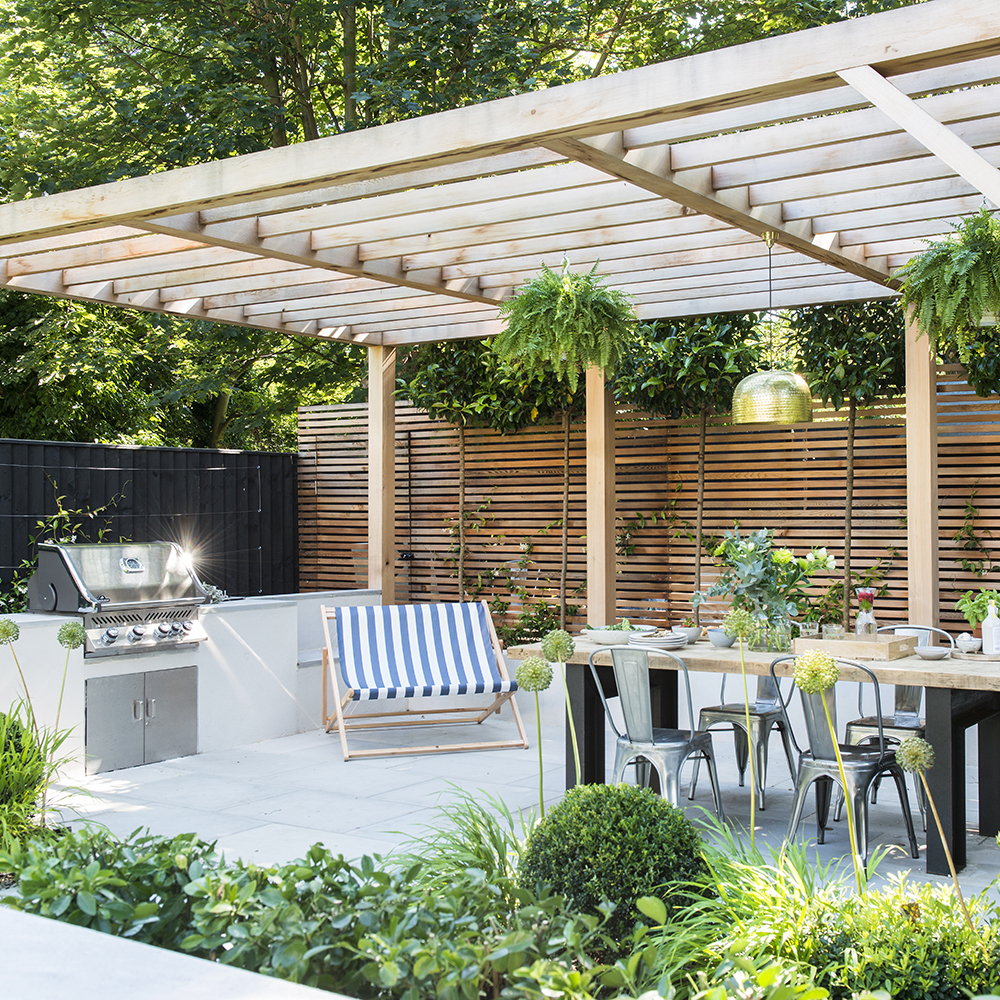
The heat from the sun can get quite intense, especially when cooking outdoors, so installing an outdoor pergola to provide shade for an outdoor kitchen is an easy way of preventing the heat from becoming too uncomfortable. Luckily, there are plenty of pergola ideas to draw inspiration from.
While an open-style pergola won’t provide full protection from rain, having panels or fencing on two (or three) sides will help shield the area from wind and draughts.
Sign up to our newsletter for style inspiration, real homes, project and garden advice and shopping know-how
'Pergolas are a fantastic addition to any outdoor kitchen, offering functional and aesthetic benefits,' says Murray Michel, garden maintenance and product expert at Clear Amber. 'They create a secluded, private feel in your outdoor space, allowing you to enjoy dining and entertaining without feeling exposed.
'The open-sided structure of a pergola gives you the freedom to customise the level of enclosure. By adding a trellis or plastic sheets for garden screening, you can achieve the perfect balance of openness and privacy. Covering the pergola with a clear solid glazing sheet makes it viable to use in all weather conditions, providing a versatile outdoor kitchen dining experience that is enjoyable year-round.'

Murray Michel is the product innovation team leader at Clear Amber, a manufacturer specialising in roofing, pergolas, guttering and decking systems for DIY and trade. With over 30 years of experience, he works to develop new ranges that make customers' installations easier and smarter.
2. DIY for bespoke coverage
Opting for a self-build construction will allow a timber pergola to be tailored to the exact size and shape of the outside space, and tie in nicely with the rest of your DIY outdoor kitchen ideas. Stretching it to span the entire width of a patio or terrace creates continuity outdoors, and an overhead structure can be a useful device when it comes to zoning an outside space.
Hanging greenery and suspending light fittings from overhead beams help to break up the space visually and create separate cooking, eating and seating zones.
Remember, there are a few things to consider when building a pergola that you'll want to tick off before you start.
3. Think about ventilation

When building an outdoor kitchen, providing adequate ventilation for gas, wood or charcoal-burning appliances in sheltered spaces is an essential safety requirement, and helps make the space more comfortable to spend time in, too.
'One effective method is the installation of outdoor-rated range hoods above grills and cooking areas, which are excellent at venting smoke and odours,' says Sam from Tiger. 'Ceiling fans can also be installed to help circulate air and disperse smoke, enhancing the comfort of the area.
'Designing the kitchen with open sides allows for natural airflow and ventilation, while incorporating vents into the roof structure helps hot air escape, improving air circulation.
'Pergolas, with their open-sided design, naturally promote good ventilation and can be an excellent choice for an outdoor kitchen. Additionally, adjustable louvred panels can be used in walls or roofs to control airflow and provide ventilation as needed.'
Bear in mind that metal flues get extremely hot, so always position them so they're not touching wooden structures, and make sure they're away from overhead greenery so they aren’t a fire hazard. Knowing how to plan an outdoor kitchen is the key to success.
4. Get tough with work surfaces

Whether sheltered or open to the elements, with any outdoor kitchen it’s the worktops that bear the brunt of the weather, from direct sunlight and rain to frost and even snow. So it’s essential to choose outdoor countertop ideas which are weather-resistant, hardwearing and durable.
Natural materials like stone and quartz are tough and impervious to the weather, and opting for an integrated outdoor sink and worktop in the same material will ensure a seamless finish and prevent dirt from accumulating in joins.
Concrete worktops are also notoriously tough, so they're good for the outdoors, while stainless steel is robust and won’t rust in wet weather. Easy-clean materials that won’t stain or mark with greasy barbecue food are a must, too.
5. Opt for an outdoor cooking hut
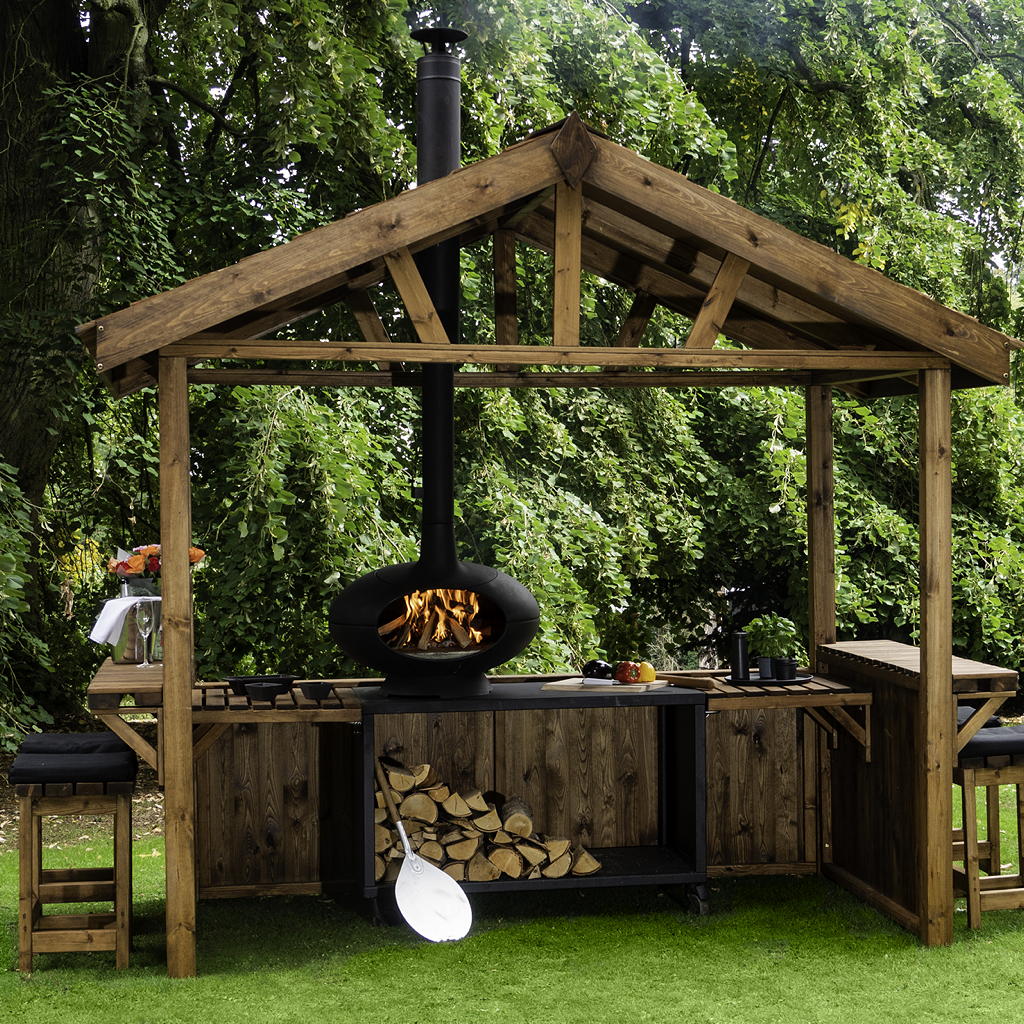
Once buying an outdoor kitchen is out of the way, try dedicating a spot for cooking and entertaining with a purpose-built hut that can be set up as a bolt-hole further away from the house and enjoyed all season round.
A fabulous focal point for a garden, the hut is built around an outdoor oven that incorporates an insulated flue system and chimney which will help keep the hut warm and cosy, too. Interior shelves provide prep space for the chef, while exterior side shelves provide extra surface space for guests to sit and get in on the action. It's also a great way of making an outdoor kitchen look more expensive.
Get the look
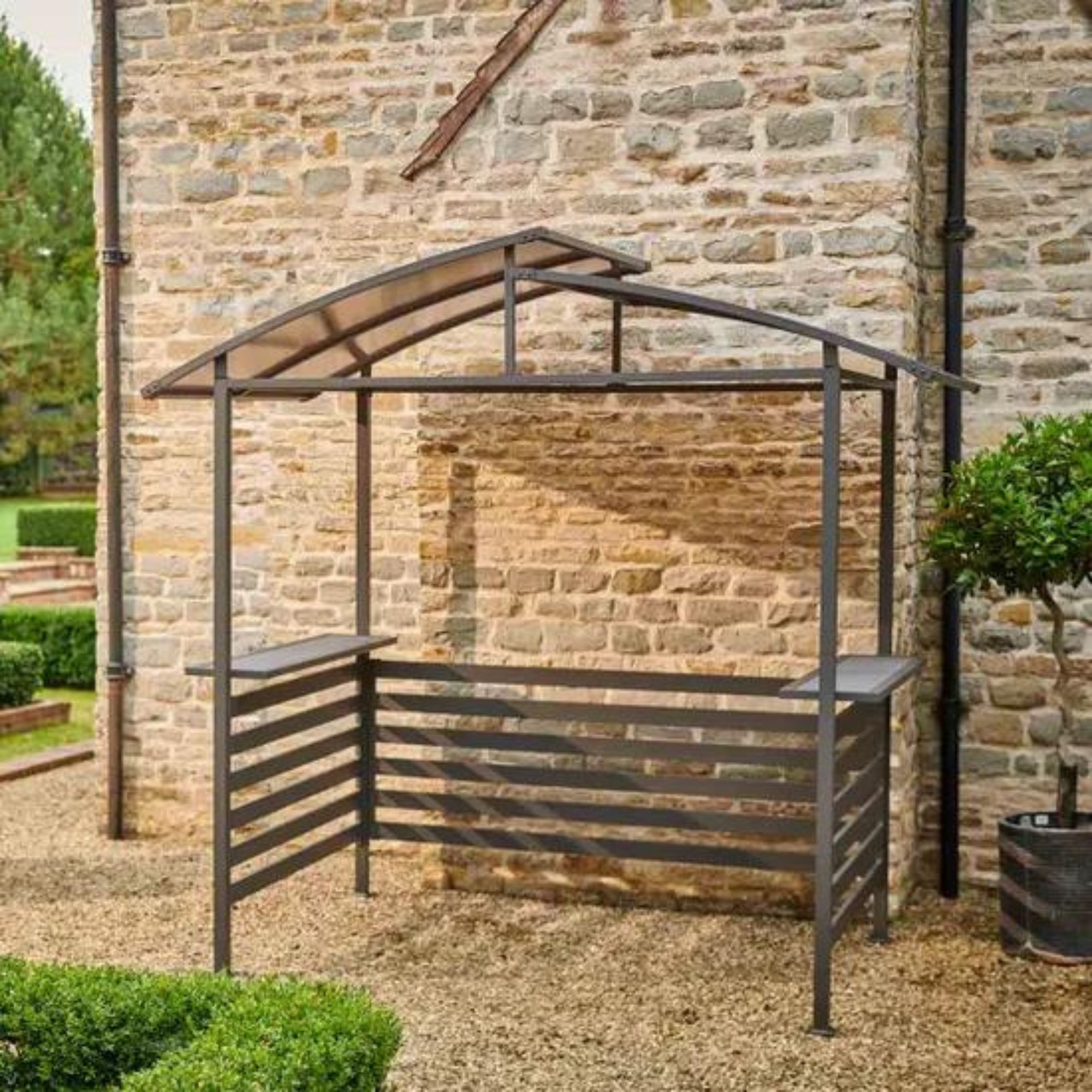
Practicality and style work together with this BBQ panalsol.

Cover your dining area with this sleek free-standing pergola which has a retractable canopy.
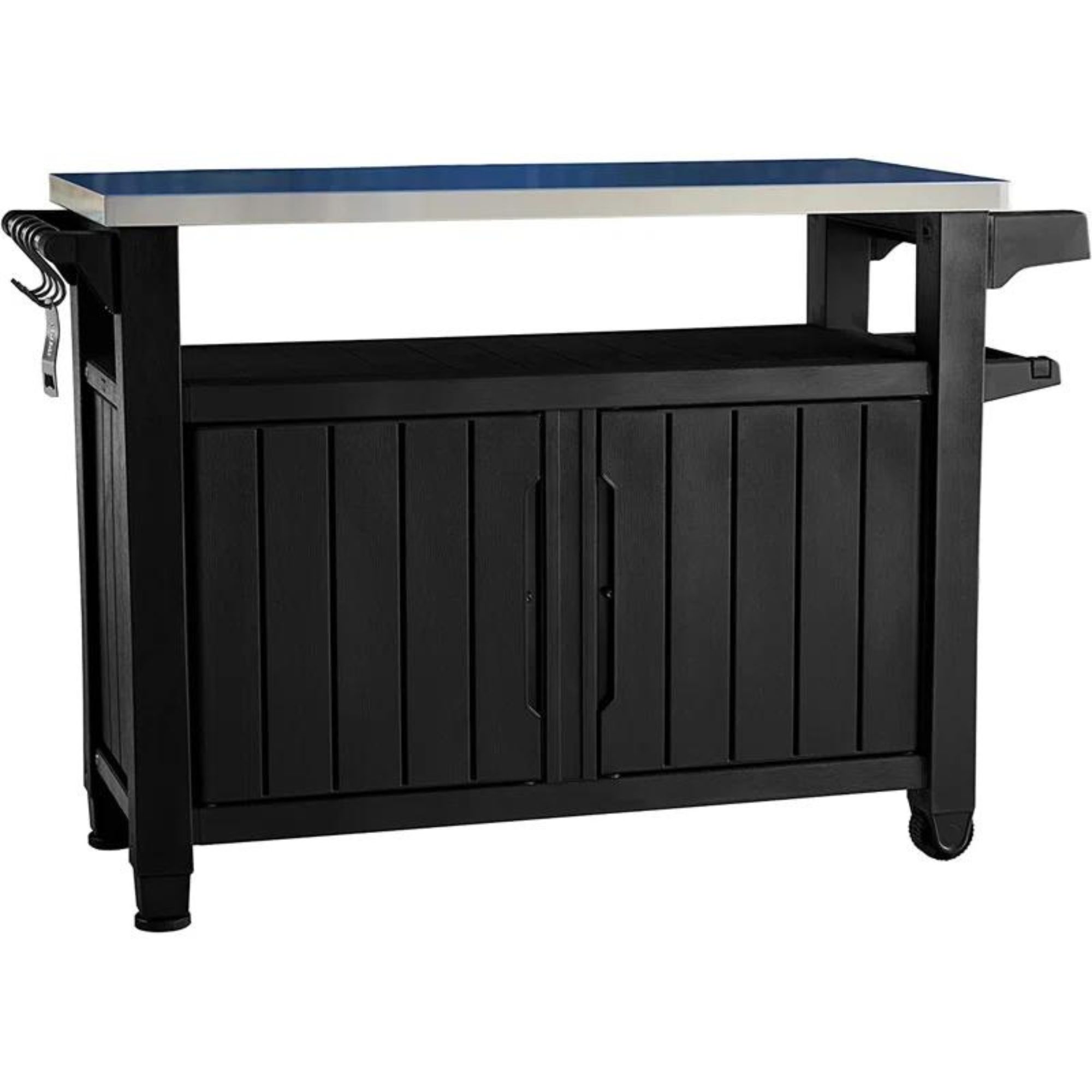
6. Try an easy-up shelter

For a less-permanent option, try a metal-framed shelter that will provide direct coverage for the best BBQ and grill area so that rain doesn’t stop play.
The Kettler BBQ Panalsol from Robert Dyas has a powder-coated aluminium frame that stays rust-free when left outside. It also has two glass side tables for resting tools and drinks on, and fixing plates to keep it securely in place during high winds.
7. Consider a free-standing pergola

A stand-alone pergola is a good covered outdoor kitchen idea if your cooking set-up is positioned slightly further away from the house, especially if you have an incorporated garden seating area. In a large garden or multi-functional outdoor space, a free-standing structure will help to define the area better, making it instantly visible and more obvious to guests as a gathering point.
While pergolas tend to be open on all four sides, adding timber cladding to one side will help to enclose the area a little and provide a backdrop for kitchen units, cooking appliances and extra storage.
8. Consider an easy-open retractable cover

For a semi-permanent outdoor covering for an outdoor kitchen, consider a pergola roof idea like a retractable awning. An awning will give protection from the hot sun, plus shelter from rain so that wet weather won’t ruin the occasion and can either be manually operated or motorised for extra ease and speed.
'Retractable awnings are flexible and can be extended or retracted as needed, making them ideal for providing shade and shelter when necessary,' says Sam from Tiger.
Fixed or freestanding, a pergola can be installed in a spot that suits the space, whether directly adjacent to the house on a patio or further along the garden in a purpose-built spot.
An awning or louvred roof is safe to use above outdoor cooking equipment provided that any flues are positioned a minimum of 0.3 metres from the underside of the roof and any side screens are kept safely away from heat surfaces.
9. Weatherproof your kitchen kit
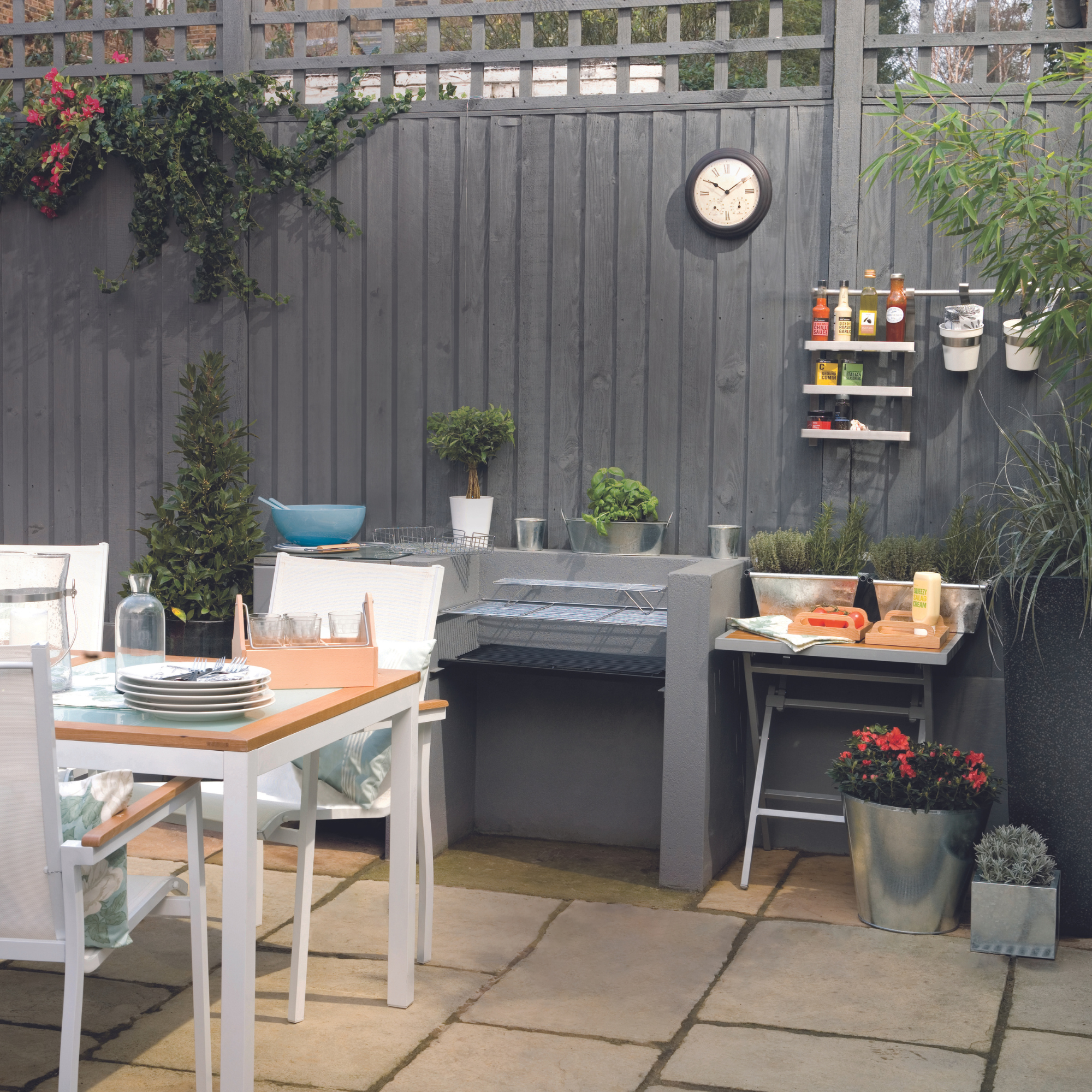
Choosing weatherproof materials is key when setting up an outdoor kitchen. Even when positioned undercover or in a sheltered spot, the kitchen might still be partly open to the elements, so appliances and units built to withstand all weathers are a must.
Stainless steel is known for its hard-wearing characteristics and durability so is a hardy choice for an outdoor kitchen. Resistant to impact, corrosion and extreme temperatures, its antibacterial properties won’t affect or contaminate food, while the easy-clean surface requires little maintenance.
Dirt can build up in between joints, corners, compartments and around control buttons, but a regular wipe-down with mild soap and water is all that’s required to remedy this. Stainless steel tops and enamelled-finish doors are heat-proof, weather-resistant and super-easy to keep clean.
10. Pick portable pieces
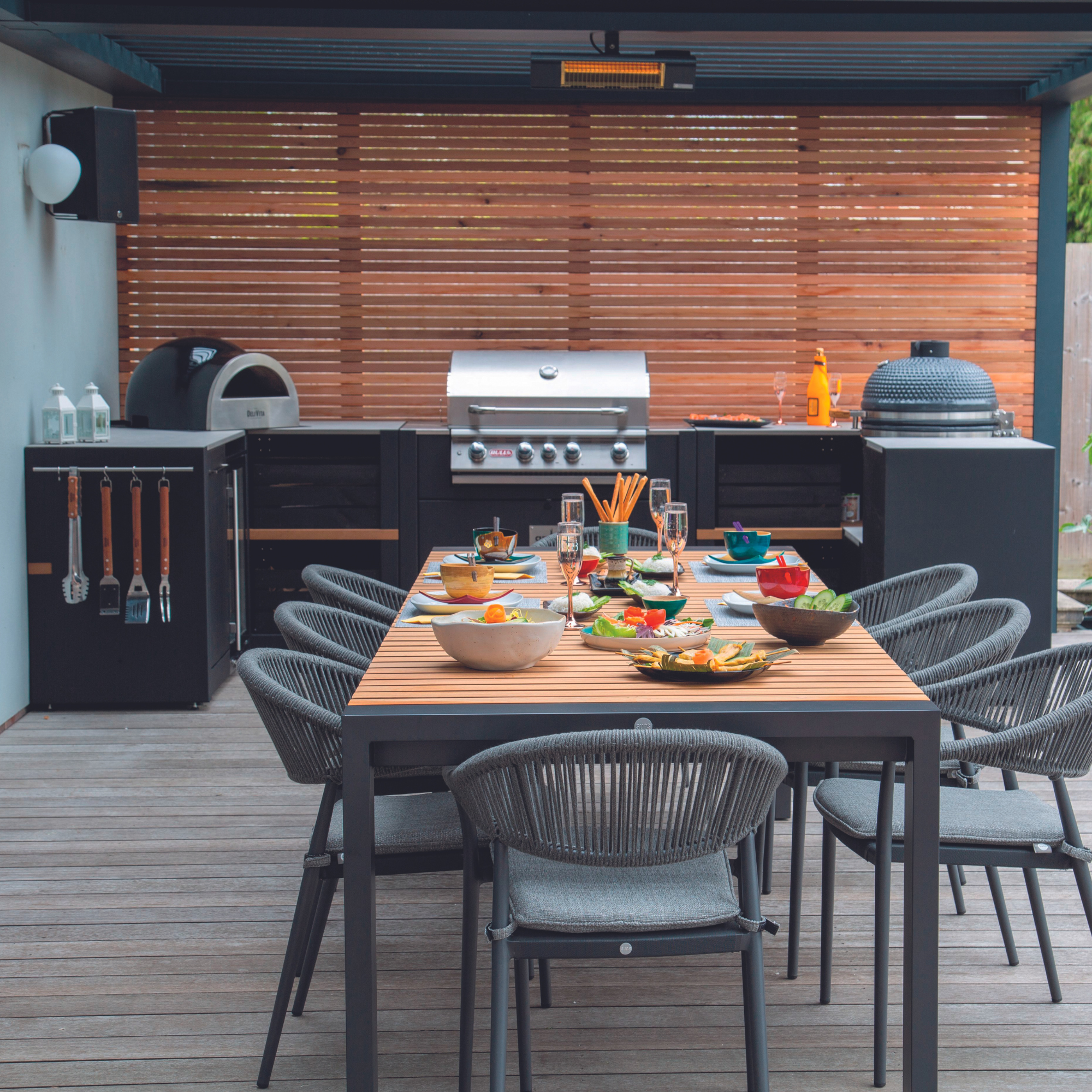
Easy-to-manoeuvre pieces will make setting up an outdoor kitchen a breeze. Lighter-weight units on castors like the Keter BBQ Table from Wayfair can be moved in and out of play as needed. Plus, they are easily shifted into a garden shed or garage out of season.
11. Make the indoor-outdoor transition seamless
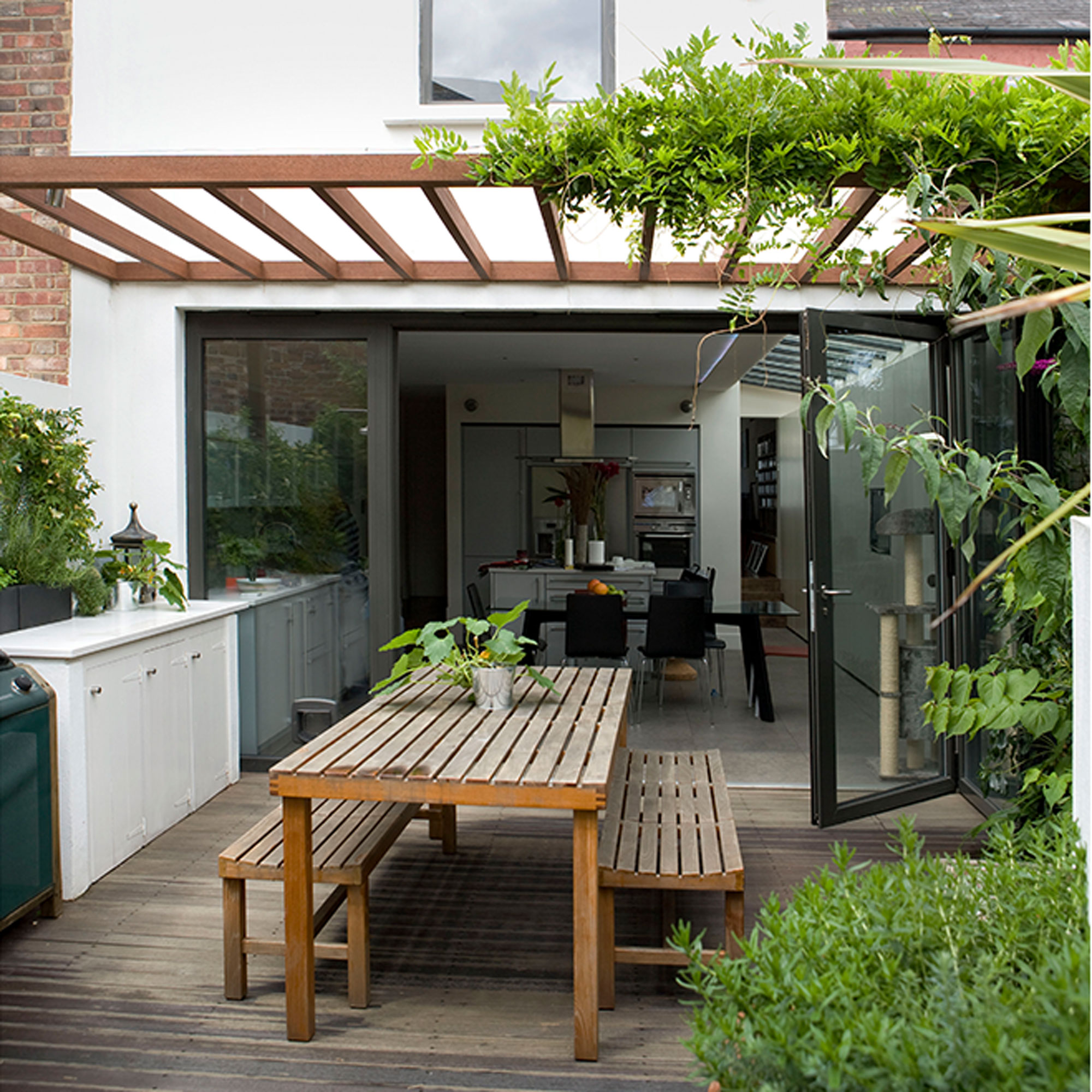
Bi-fold doors create easily accessible indoor-outdoor spaces that are a prime spot for an open-air kitchen. A pergola shade makes the perfect patio cover-up, easily attaching to the exterior of a house to extend the usability of the outdoor area.
Give a pergola extra shade and coverage learning how to train wisteria and other climbing plants to grow over it. Fast-growing climbers will establish themselves quickly and can provide coverage in as little as two years. Make sure any trailing greenery doesn’t overhang the cooking area too much.
FAQs
Should an outdoor kitchen be covered?
Though weatherproof materials are available to ensure your outdoor kitchen can withstand the elements, covering the area is a bonus.
'An outdoor kitchen should ideally be covered to maximise its usability and longevity,' says Sam from Tiger. 'Covering your outdoor kitchen provides essential protection from the elements such as rain, snow, and excessive sunlight, which in turn extends the life of your appliances and furniture.
'Having a cover also reduces debris, like leaves and dirt, that can accumulate, making cleaning and maintenance much easier.'
What is the cheapest way to cover an outdoor kitchen?
'For those looking to cover their outdoor kitchen on a budget, pergolas are a cost-effective solution that enhances the overall ambience,' says Murray from Clear Amber. 'Adding a roof to your pergola is a straightforward upgrade that significantly improves its functionality, allowing you to protect your cooking equipment and guests from the elements.
'Solid or twinwall plastic sheets are excellent options for roofing. With a well-designed pergola, you can create an inviting outdoor kitchen that serves as the perfect central space for summer BBQs, pizza nights and more, making every gathering a memorable one.'
Experimenting with covered outdoor kitchen ideas can transform your outdoor living space into a hub for alfresco dining. There are countless outdoor kitchen ideas for every garden, big or small, but there's also plenty of room for creativity if you want to enclose your dining area and protect it from the elements.
'A covered kitchen allows for more frequent use regardless of the weather, making it a practical addition to any outdoor space,' says Sam Jenkinson, pergola expert at Tiger. 'The cover also offers shade and shelter, enhancing the comfort of the area for cooking and dining.'
No matter the size of your alfresco space – even if you're looking for small outdoor kitchen ideas – if you want to provide the area with a little more protection, you've come to the right place.

Lisa is a freelance journalist who has written about interiors for more than 25 years. Previously editor of Style at Home magazine, she has worked on all the major homes titles, including Ideal Home, Country Homes & Interiors, 25 Beautiful Homes and Homes & Gardens. She has covered pretty much every area of the home, from shopping and decorating, crafts and DIY to real homes and makeovers and now regularly writes gardening stories for Ideal Home.